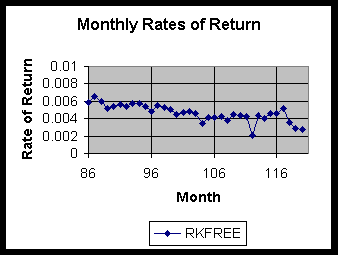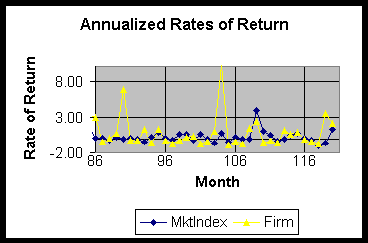Temple University
Department of Economics
1. (HT) In order to test whether four brands of gasoline give equal performance in terms of mileage, each of three cars was driven with each of the four brands of gasoline. Then each of the (3x4=12) possible combinations was repeated four times. The number of miles per gallon for each of the four repititions in each cell is recorded in the table below.
|
Brand of gasoline |
||||||||
|
Car |
1 |
2 |
3 |
4 |
||||
|
1 |
21.0 |
14.9 |
16.3 |
20.0 |
15.8 |
19.4 |
17.8 |
17.3 |
|
16.2 |
18.8 |
15.2 |
21.6 |
14.5 |
14.8 |
18.2 |
20.4 |
|
|
2 |
20.6 |
19.5 |
15.5 |
16.8 |
16.6 |
13.7 |
18.1 |
17.1 |
|
20.8 |
18.9 |
17.4 |
19.4 |
18.2 |
16.1 |
21.5 |
19.1 |
|
|
3 |
14.2 |
13.1 |
17.4 |
18.1 |
15.2 |
16.7 |
16.3 |
16.4 |
|
16.8 |
17.4 |
16.4 |
16.9 |
17.7 |
18.1 |
17.9 |
18.8 |
|
The possible model of gasoline consumption is
![]()
i=1,2,3 cars
j=1,2,3,4 brands of gas
and![]() is the interaction between car and brand.
is the interaction between car and brand.
Test the following hypotheses:
a. The type of car does not matter.
b. The type of gasoline does not matter.
c. Neither the car nor the gasoline matters.
d. The interaction effect is zero.
Note that I added a few lines to the question above in order to provide alittle more clarity. Since you already have the data I won't reproduce it. In what follows I provide answers to the questions using both ANOVA and regression analysis. First comes the ANOVA output using EXCEL.
|
Anova: Two-Factor With Replication |
||||||
|
SUMMARY |
Gas 1 |
Gas 2 |
Gas 3 |
Gas 4 |
Total |
|
|
Car 1 |
||||||
|
Count |
4 |
4 |
4 |
4 |
16 |
|
|
Sum |
70.9 |
73.1 |
64.5 |
73.7 |
282.2 |
|
|
Average |
17.73 |
18.28 |
16.13 |
18.43 |
17.64 |
|
|
Variance |
7.40 |
9.13 |
5.08 |
1.87 |
5.58 |
|
|
Car 2 |
||||||
|
Count |
4 |
4 |
4 |
4 |
16 |
|
|
Sum |
79.8 |
69.1 |
64.6 |
75.8 |
289.3 |
|
|
Average |
19.95 |
17.28 |
16.15 |
18.95 |
18.08 |
|
|
Variance |
0.82 |
2.64 |
3.47 |
3.56 |
4.40 |
|
|
Car 3 |
||||||
|
Count |
4 |
4 |
4 |
4 |
16 |
|
|
Sum |
61.5 |
68.8 |
67.7 |
69.4 |
267.4 |
|
|
Average |
15.38 |
17.20 |
16.93 |
17.35 |
16.71 |
|
|
Variance |
4.23 |
0.53 |
1.67 |
1.47 |
2.24 |
|
|
Total |
||||||
|
Count |
12 |
12 |
12 |
12 |
||
|
Sum |
212.2 |
211 |
196.8 |
218.9 |
||
|
Average |
17.68 |
17.58 |
16.40 |
18.24 |
||
|
Variance |
7.20 |
3.61 |
2.94 |
2.36 |
||
|
ANOVA |
||||||
|
Source of Variation |
SS |
df |
MS |
F |
P-value |
F crit |
|
Car |
15.61 |
2 |
7.80 |
2.24 |
0.12 |
3.26 |
|
Brand |
21.58 |
3 |
7.19 |
2.06 |
0.12 |
2.87 |
|
Interaction |
36.12 |
6 |
6.02 |
1.73 |
0.14 |
2.36 |
|
Within |
125.53 |
36 |
3.49 |
|||
|
Total |
198.84 |
47 |
||||
In the ANOVA table the row labeled 'Car' provides the information for the hypothesis that the type of car does not matter. The observed F is 224 and the critical F at 5% is 3.26, hence we cannot reject the null. The labeled 'Brand' has an observed F=2.06 against a critical F=2.87. Again, we cannot reject the null. To test the hypothesis that neither 'Car' nor 'Brand' matters we add together the two SS and divide by the total degrees of freedom, then divide that result by the 'within MS' to get an observed F=2.13. The 5% critical F for 5 and 36 degrees of freedom is F=2.49 (about). We cannot reject the null. From the table we also cannot reject the null hypothesis that there are no interaction effects.
Now for some OLS results: The first regression model has an intercept and dummies for 'type of car' and 'brand of gas". You will note that the 'Regression Sum of Squares (37.19) is equal to the sum of the 'Car' and 'Brand' SS in the table above.
|
SUMMARY OUTPUT |
||||||
|
Regression Statistics |
||||||
|
Multiple R |
0.43 |
|||||
|
R Square |
0.19 |
|||||
|
Adjusted R Square |
0.09 |
|||||
|
Std Error |
1.96 |
|||||
|
Observations |
48 |
|||||
|
ANOVA |
||||||
|
df |
SS |
MS |
F |
Significance F |
||
|
Regression |
5 |
37.19 |
7.44 |
1.93 |
0.11 |
|
|
Residual |
42 |
161.66 |
3.85 |
|||
|
Total |
47 |
198.84 |
||||
|
Coefficients |
Standard Error |
t Stat |
P-value |
Lower 95% |
Upper 95% |
|
|
Intercept |
17.48 |
0.69 |
25.20 |
0.00 |
16.08 |
18.88 |
|
Car1 |
0.93 |
0.69 |
1.33 |
0.19 |
-0.47 |
2.32 |
|
Car 2 |
1.37 |
0.69 |
1.97 |
0.06 |
-0.03 |
2.77 |
|
B 1 |
-0.56 |
0.80 |
-0.70 |
0.49 |
-2.17 |
1.06 |
|
B2 |
-0.66 |
0.80 |
-0.82 |
0.42 |
-2.27 |
0.96 |
|
B3 |
-1.84 |
0.80 |
-2.30 |
0.03 |
-3.46 |
-0.23 |
|
SUMMARY OUTPUT |
In the second regression model there are dummies for 'Car', 'Brand' and the interaction between the two, for a total of eleven dummies and one intercept. Now the Regression Sum of Squares is equal to the sum of SS for 'Car', 'Brand' and 'Interaction' in the original ANOVA table. |
|||||
|
Regression Statistics |
||||||
|
Multiple R |
0.61 |
|||||
|
R Square |
0.37 |
|||||
|
Adjusted R Square |
0.18 |
|||||
|
Std Error |
1.87 |
|||||
|
Observations |
48 |
|||||
|
ANOVA |
||||||
|
df |
SS |
MS |
F |
Significance F |
||
|
Regression |
11 |
73.31 |
6.66 |
1.91 |
0.07 |
|
|
Residual |
36 |
125.53 |
3.49 |
|||
|
Total |
47 |
198.84 |
||||
|
Coefficients |
Standard Error |
t Stat |
P-value |
Lower 95% |
Upper 95% |
|
|
Intercept |
17.35 |
0.93 |
18.58 |
0.00 |
15.46 |
19.24 |
|
C1 |
1.08 |
1.32 |
0.81 |
0.42 |
-1.60 |
3.75 |
|
C2 |
1.60 |
1.32 |
1.21 |
0.23 |
-1.08 |
4.28 |
|
B1 |
-1.98 |
1.32 |
-1.50 |
0.14 |
-4.65 |
0.70 |
|
B2 |
-0.15 |
1.32 |
-0.11 |
0.91 |
-2.83 |
2.53 |
|
B3 |
-0.43 |
1.32 |
-0.32 |
0.75 |
-3.10 |
2.25 |
|
c1b1 |
1.28 |
1.87 |
0.68 |
0.50 |
-2.51 |
5.06 |
|
c1b2 |
0.00 |
1.87 |
0.00 |
1.00 |
-3.79 |
3.79 |
|
c1b3 |
-1.87 |
1.87 |
-1.00 |
0.32 |
-5.66 |
1.91 |
|
c2b1 |
2.98 |
1.87 |
1.59 |
0.12 |
-0.81 |
6.76 |
|
c2b2 |
-1.52 |
1.87 |
-0.82 |
0.42 |
-5.31 |
2.26 |
|
c2b3 |
-2.37 |
1.87 |
-1.27 |
0.21 |
-6.16 |
1.41 |
Using the regression sums of squares we can do the tests requested in parts c. and d. In order to do the test in parts a. and b. I would have to provide the results for two more regressions. Do you know what their specifications would be? What results, in terms of SS, would you expect to see?
Finally, note that none of the regression coefficients in either model are different from zero in a statistical sense.


There is much more variation in the market rate and in the rate for Motorola than there is in the risk free rate.
|
Average |
0.007 |
0.008 |
|
Std Dev |
0.069 |
0.090 |
|
Mkt-RKF |
Motor-RKF |
This done by applying Annual=(((1+Monthly)^12)-1) to the appropriate series.
d. Plot the annualized series for Firm and MktIndex for the last 36 months.

The second plot annualizes the monthly data {(((1+monthly r of r)^12)-1)} after subtracting out the return one could have earned by investing in a risk free bond.
f. From the annualized data estimate the coefficients in the regression
![]()

![]()
From the regression output:
![]() and
and ![]()
From the regression output the observed t is 3.38. This is significantly different from zero, so reject the null.
The observed t is .56. This is not different from zero, so do not reject the null.